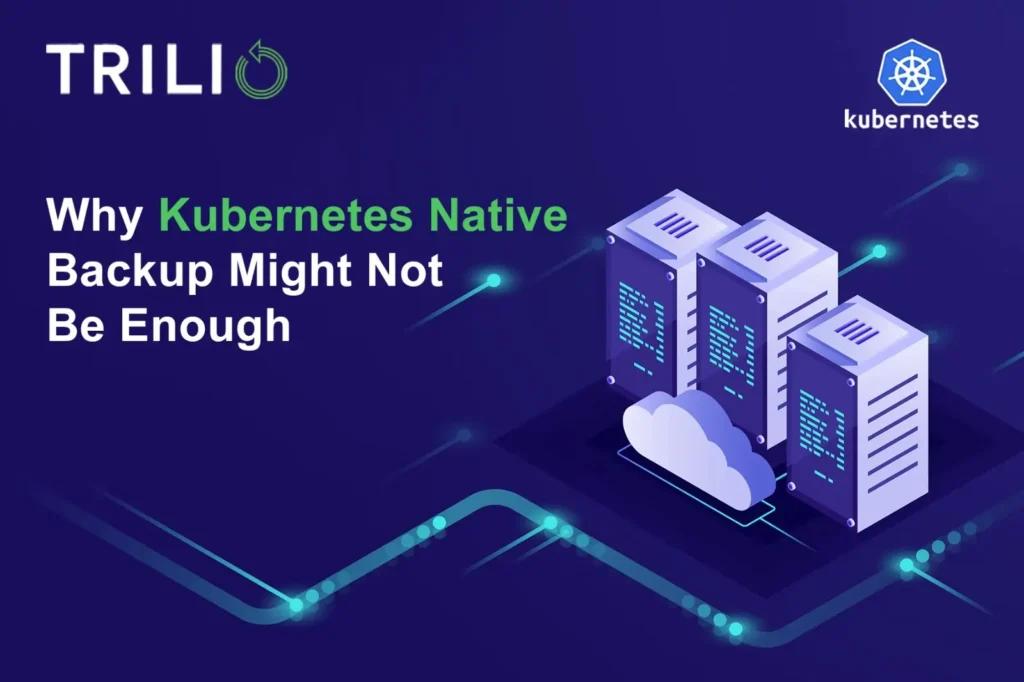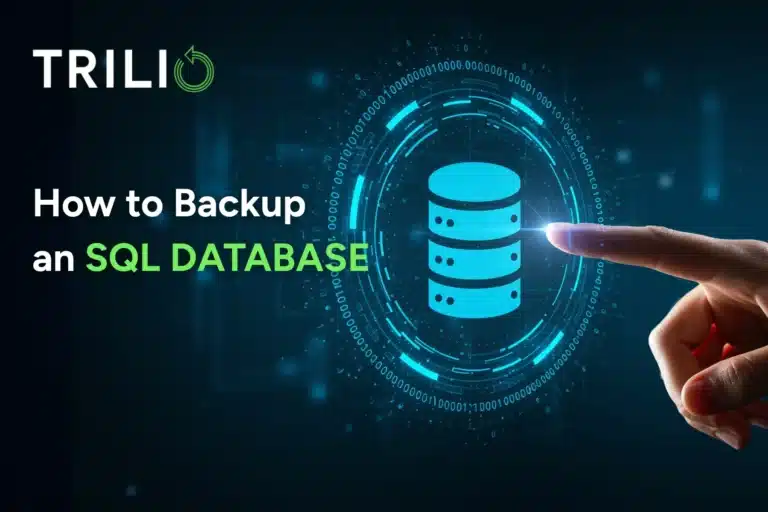Chances are, if you’re involved in software development, you’ve worked with Kubernetes or at least discussed it. Widespread adoption is not surprising since it’s caused by its ability to offer organizations flexibility in application deployment, scaling, and management. However, the inherent complexities of Kubernetes environments also give rise to unique data protection challenges. While Kubernetes native backup provides a starting point for data protection, it often falls short when it comes to ensuring comprehensive application-level protection, granular recovery, and seamless operations across diverse Kubernetes deployments.
Read our Kubernetes disaster recovery best practices guide to learn how to protect your Kubernetes applications.
In this blog, we’ll explore the limitations of Kubernetes native backup and explain how Trilio can help organizations overcome these challenges, offering enterprise-grade backups and streamlined disaster recovery for their business-critical applications.
Kubernetes Native Backup: Understanding the Limitations
Kubernetes offers built-in mechanisms for basic data protection, such as snapshots and replication. These tools provide a degree of integration within the Kubernetes environment and can serve as a starting point for safeguarding against accidental deletions or corruption. Snapshots, facilitated by the Container Storage Interface (CSI), capture the state of a Persistent Volume at a specific moment. This provides a point-in-time recovery option in case of accidental data deletion or corruption. At the same time, replication helps ensure high availability by maintaining multiple pod copies across different nodes.
However, as the complexity and amount of data within Kubernetes deployments increases, especially for fast-growing organizations, relying only on Kubernetes native backup often leads to challenges as:
- Operational Complexity: Configuring and managing native backup solutions, especially in large-scale or multi-cluster environments, can become a significant operational burden. Native tools often involve working with Kubernetes primitives like Persistent Volumes (PVs), Persistent Volume Claims (PVCs), and custom resource definitions (CRDs), requiring specialized knowledge and manual configuration.
- Application-Agnostic Nature: Native backup tools generally operate at the storage volume level. They don’t fully understand how the different parts of an application work together, their dependencies, and their relationships within the Kubernetes environment, which are essential for ensuring consistent backups and enabling granular recovery of specific application components. This can make restoring only the required parts of a complex application difficult.
- Granular Restoration Challenges: Restoring individual components or data objects within complicated, multi-tier applications can be challenging with native tools alone. Extracting and re-injecting specific data often requires manual processes and a deep understanding of Kubernetes object relationships.
Limited Scope: Most native backup solutions primarily focus on protecting data within a single cluster. They don’t provide the mechanisms necessary to orchestrate backup and recovery processes across multiple clusters or hybrid cloud scenarios, leaving organizations vulnerable to broader outages or disasters.
Enhancing Native Protection with Trilio for Kubernetes
Trilio is designed to address the limitations of native backup solutions and provide a more robust, application-centric approach to data protection in Kubernetes environments. Here’s a closer look at how it augments Kubernetes’ capabilities:
Simplified Operations
Trilio has a user-friendly interface and streamlined workflows for the orchestration of data protection operations across multiple Kubernetes environments. This intuitive approach significantly reduces operational complexities. Instead of struggling with command-line tools and Kubernetes primitives, administrators can effortlessly manage backup policies, schedules, and restoration processes.
Application-Centric Protection
Trilio’s application-centric approach goes far beyond simplistic volume-level backups. It understands the relationships between Kubernetes objects, dependencies, and their metadata. This is achieved through flexible identification mechanisms – Trilio works with user-defined labels, Helm release names, and even operator-based constructs to map application boundaries. Whether it’s finding all resources with a specific label or decoding Helm secrets, Trilio carefully identifies even dependent subcharts. This intelligence extends to operator-based applications, where it leverages custom resources, operator resources, and owner references (or fallbacks to labels) to pinpoint all the pieces of a complex application.
This thoroughness is the key difference. Trilio’s backups aren’t just a collection of data volumes; they’re a precise snapshot of the Kubernetes objects and relationships that define your application. This deep understanding is what allows teams to have truly reliable backups, where every component and dependency is accounted for, even in highly complex, distributed Kubernetes deployments.
Granular Control and Flexibility
Trilio provides granular control over backups and restores, allowing users to select individual objects, complete namespaces, or entire applications as needed. This granular approach allows you to precisely restore specific components or data sets within an application, without the need to disrupt or restore the entirety of the application.
Enterprise-Ready Features
Trilio is engineered to support production-grade Kubernetes deployments. It seamlessly scales to match the demands of your environment, offering enterprise-grade security measures such as role-based access control and robust encryption. Additionally, Trilio incorporates ransomware protection features like immutability to provide a powerful defense against malicious attacks.
Learn why DETASAD chose Trilio’s self service backup over other
Key Use Cases
Trilio offers significant advantages in scenarios where native Kubernetes backup is not enough, including:
- Disaster Recovery: Trilio lets organizations effortlessly backup applications across multiple clusters or different cloud environments. This cross-environment capability ensures swift recovery in the event of outages or disasters, guaranteeing minimal downtime.
- Application Migration: Complex Kubernetes applications can be migrated effortlessly between clusters or cloud providers using Trilio. This allows organizations to achieve infrastructure flexibility and optimize costs without risking data loss or extended downtime.
- Test/Dev: Production data can be securely cloned using Trilio to create realistic development and testing environments. This practice enables developers to work with accurate copies of production data, accelerating development cycles, and improving software quality.
Learn how a lead telecom firm solved k8s backup and recovery with Trilio
Conclusion
Kubernetes native backup tools provide a basic foundation for data protection. However, as your Kubernetes deployments become more complex and your data protection requirements increase, a specialized solution like Trilio offers significant advantages. Trilio addresses the limitations of native tools by providing application-centric backups, granular recovery, intuitive management, and enterprise-level security and scalability. If you’re looking to safeguard your mission-critical Kubernetes applications and enhance your disaster recovery and data migration capabilities, Trilio for Kubernetes is a powerful solution to consider.
Request a demo to learn more about how Trilio can help you ensure your business continuity with its backup and restore features.
FAQs
What specific features does Kubernetes lack in its native backup tools that Trilio provides, in terms of data protection and recovery?
Kubernetes primarily offers basic data protection mechanisms like snapshots but lacks comprehensive, application-aware backup solutions. Trilio fills this gap by providing application-centric backups that understand the relationships and dependencies between different components of an application. This ensures more reliable and consistent backups and facilitates granular recovery options, allowing for the restoration of specific components or data sets within an application, rather than having to restore entire volumes or applications.
How does Trilio allow organizations to recover from Ransomware attacks?
Once a backup is made, it cannot be altered or deleted within a specified retention period, effectively preventing ransomware from encrypting or destroying backup data. This immutability is critical for ensuring that, in the event of a ransomware attack, organizations have unaffected versions of their data to restore from. Integrating seamlessly with Kubernetes, Trilio leverages the platform’s inherent capabilities while adding its protective layer, ensuring backups are both secure from tampering and reflective of the application’s current state.
What are the performance impacts of using Trilio for backup and recovery operations in large-scale Kubernetes deployments?
Trilio is designed to be minimally invasive and highly efficient. Trilio is built to scale with the size of Kubernetes deployments, ensuring that its backup and recovery operations do not significantly impact the performance of the underlying infrastructure. This is achieved through optimized data management practices and the ability to perform application-consistent backups without needing to pause or slow down running applications significantly. However, as with any system, the actual impact can vary based on the specific configurations, the amount of data being handled, and the network infrastructure’s capabilities.




